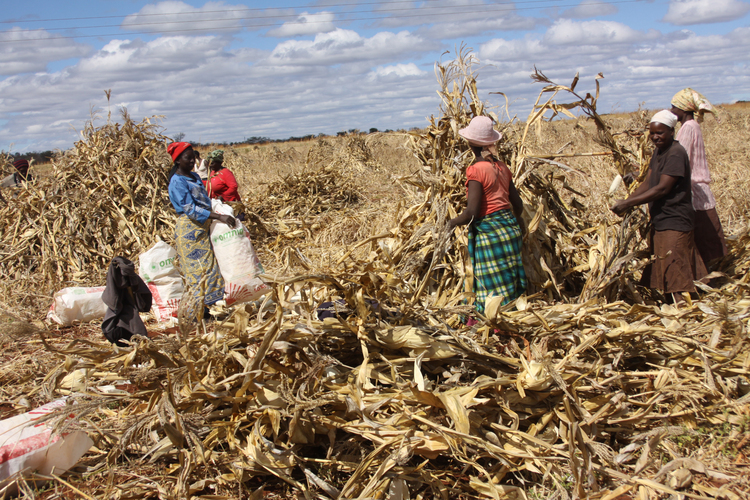
The Sunday Mail

A protracted legal battle is looming between private grain traders and Government after gazetting of the US$390-per-tonne minimum maize and sorghum price.
Statutory Instrument 122 of 2014, Agriculture Marketing Authority Regulations (Minimum Grain Producer Prices) 2014 compels companies and individuals to buy maize from growers at US$390 per tonne.
Under the new regulations, the Agriculture Minister may announce the minimum producer price of maize, sorghum, pearl millet (mhunga), finger millet (rapoko) and wheat at the beginning of the marketing season.
Only registered buyers are allowed to purchase maize and those companies and individuals buying below the stipulated price will be fined or imprisoned for up to three months.
Furthermore, the grain will be forfeited to the State.
As farmers welcomed the regulations, private grain traders were crying foul, saying the new measures were both “excessive, unfair and unsustainable”.
Stakeholders also argue that the prices of mealie-meal, alcohol, stockfeed and other grain by-products will increase, forcing many traders out of business.
Mr Tafadzwa Musarara, chair of the Grain Millers Association of Zimbabwe, is advocating for scraping of the regulations and has called upon Government to allow free market forces to determine grain prices.
“This Statutory Instrument is not fair to both the traders and the growers. Most of our traders are financed and now the financiers are instructing our members to stop buying grain. On the other hand, the farmers are in desperate need of money. Free market forces should be left to determine the price of grain,” Mr Musarara said.
According to media reports, grain traders will mount a legal challenge on the constitutionality of the new regulations.
Following announcement of the regulations, some farmers are alleged to have approached contract farming companies demanding that the firms top-up the money they had paid them so that they are in tandem with the stipulated US$390 per tonne.
This is despite the fact that the farmers had already signed contracts stipulating they would be paid less.
Mr Musarara foresees a lot of problems arising from the Statutory Instrument in question.
“This new law is silent and does not address the issue of contract farming. Furthermore, the law also criminalises civil matters. Buyers’ constitutional right to freedom to contract is trampled upon.”
A snap survey by The Sunday Mail Extra showed that grain traders themselves are divided, with some ignoring the Grain Millers Association of Zimbabwe’s directive to suspend procurement.
The Grain Millers Association of Zimbabwe has 68 registered traders.
Mr Peter Gambara, an agricultural economist, is doubtful that the regulations will achieve their intended purposes.
“It is tricky to say that the Statutory Instrument will bring sanity to the grain trading sector. We are likely going to see private buyers temporarily suspending their operations. We are likely going to see many buyers resorting to buying grain on the black market,” Mr Gambara said.
In contrast, the Zimbabwe Farmers Union has welcomed the regulations which it said stimulate production.
Mr Berean Mukwende, the union’s second vice-president, said: “In the past, most of the grain traders have been acquiring maize for speculative purposes. They would buy grain at a cheaper price during harvest time, hold on to it before selling it later in the year, realising super profits in the process.”
Mr Mukwende dismissed calls for market forces to determine grain prices.
“Ours is not a perfect, free and competitive market economy. Farming inputs are expensive and there is generally a market failure. This market failure has forced Government to intervene. Grain is a national security issue and Government cannot allow a situation in which few traders hold the nation to ransom,” Mr Mukwende said.
Mr Absalom Zvidzai, a Kadoma farmer, added that the regulations would empower growers.
“The Statutory Instrument will motivate the farmers. Since the US$390 price is competitive, the farmers will be able to source their own inputs,” Mr Zvidzai said. Critics, however, say the regulations will trigger black market activities and spur cheap imports from neighbouring Zambia and South Africa.
In Zambia, the gazetted maize price is US$220 per tonne and it is US$210 in South Africa.
Zambian and South African farmers are, however, well-funded via subsidies that reduce their production costs.
Malawi in recent years saw its maize and tobacco harvests booming after the government introduced a raft of subsidies.
The US spends billions in farmer subsidies annually, while more than 40 percent of the European Union’s budget under the Common Agriculture Policy goes towards similar support.
As such, Zimbabwean farmers are operating sub-optimally when global comparisons are made.
Zambian farmers produced 3,35 million tonnes of maize in the 2013 / 2014 summer season, a remarkable improvement from the 2012 / 2013 season’s production of 2,5 million tonnes.
After setting aside strategic grain reserves of 500 000 tonnes, Zambia had a surplus of 1,15 million tonnes.
The Zambian government issued permits for the export of 17 310 tonnes of maize bran, 1 260 tonnes of brewer grit and 2 340 tonnes of maize seed. As at mid-June 2014, about 43,590 tonnes of maize had been exported to the Democratic Republic of Congo, Malawi and Tanzania.
Early this year, that country’s government gazetted a Statutory Instrument lifting the ban on maize exports.







